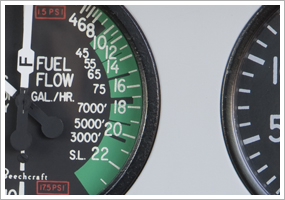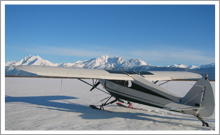| ||||
| | FT News | INSIDE AOPA | TRAINING PRODUCTS | FINAL EXAM | |||
TRAINING TIPsChecking the burn
That reminder to be skeptical about fuel gauges comes well recommended—by the adverse experiences of pilots who weren’t. This may surprise you, but fuel-related accidents occur at a rate of more than three per week, according to the AOPA Air Safety Foundation’s Fuel Awareness Safety Advisor. “The first step in knowing how much fuel you have is to think of fuel not in gallons or pounds but hours and minutes. Why think in time rather than distance? Because fuel burn is a constant—the engine, barring a malfunction, will always burn the same amount at any given combination of altitude, power setting, and mixture setting, but range will vary constantly due to changing winds and ground speeds,” it explained.
All of this leads to the other element which will arm you with the most accurate data: Does your aircraft perform as the manual states? Or, do the published numbers represent “Fuzzy Math,” the title of a September 2002 Flight Training feature on the subject? To know, compare how many gallons you take on after flight to the amount you’d expect. Adjust accordingly next time. Building in a healthy margin of error beyond that is also a good idea! YOUR PARTNER IN TRAININGPart of the process to apply for a private pilot certificate is obtaining an FAA medical certificate. This important step must happen before your first solo, and then in later years after you’ve obtained the certificate. AOPA offers many resources to help you through the process. Start your research at the medical services page and be sure to utilize products such as TurboMedical, a program that walks you through the application and its potential pitfalls. There’s lots more information on the page, so make sure you visit before your next FAA medical exam.
Did you know that student pilots who join AOPA are three times more likely to complete their flight training? Membership includes unlimited access to aviation information by phone (800/USA-AOPA, weekdays from 8:30 a.m. to 6 p.m. Eastern time) or from AOPA Flight Training Online or AOPA Online. If you're not already a member, join today and get the pilot's edge. Login information is available online. FLIGHT TRAINING NEWS‘Growing the pilot population—one youth at a time’The American pilot population has been decreasing for years, but a group of pilots at the Peachstate Aerodrome in Williamson, Ga., have launched a program to help reverse the trend—and help young people achieve their dreams of flight. The group formed the Candler Field Flying Club in November 2009 to offer affordable flight instruction for young people and pass on the legacy of flight to the next generation. After only five months, the club already has 23 members, eight of them under the age of 20. AOPA Foundation President Karen Gebhart came across this remarkable story when she traveled to the Peachstate Aerodrome/Candler Field for a pilot town hall meeting April 21. Read more >> Swiss pilots begin global trek in light sport aircraftTwo Swiss airline pilots launched April 30 on an around-the-world journey, each flying a modified Flight Design CTLS light sport aircraft. Yannick Bovier and Francisco Agullo plan to fly 27,500 miles, through 18 countries, and across five continents and two oceans. The airplanes have been modified to carry 120 gallons of fuel, plus additional navigational and survival equipment. Read more >> Baseball team to give away Cessna 150, flight lessonsThe Tucson Toros, a minor league baseball team in Arizona, unveiled its roster for 2010 along with an unusual fan promotion: a free airplane. One fan will win a Cessna 150 plus flying lessons, the team announced at a news conference at Tucson International Airport. The airplane will go to the fan who makes the most accurate throw of a baseball on Sept. 4, 2010, at the last regular season game, according to team owner Jay Zucker. Additionally, every Fireworks Friday, one fan will be chosen to fly over Hi Corbett Field stadium to view the fireworks from aloft, according to a report in the Arizona Daily Star . Minnesota State University program gets reprieveThe Minnesota State University (MSU) Mankato aviation program, whose future looked uncertain in January, has been granted a three-year reprieve. Local businesses and private donors came up with $600,000 to keep the program going. The aviation program must recruit enough new students to make it self-sustaining. It currently has about 120 students enrolled. MSU President Richard Davenport said the program’s chances of meeting those goals look good, and the university will ramp up its marketing efforts, according to a report in the Mankato Free Press . School briefs
Inside AOPALearn weather’s big pictureDo you know how a cold front differs from a warm front? How about what type of weather is generated from each of them? You will if you take the AOPA Air Safety Foundation’s course WeatherWise: Air Masses and Fronts . The Air Safety Foundation takes concepts that are sometimes difficult to understand and breaks them down into approachable, interactive courses such as this. Learn how heat, moisture, and wind affect the weather. You’ll learn all about weather’s big picture with the foundation’s course. AOPA comes to the rescue for member’s medicalAfter AOPA member George Jordan received radiation treatments for prostate cancer, he was able to keep flying as long as he provided proper medical documentation. It wasn’t until two years later that a problem with his medical certificate appeared. He didn’t lose his medical, but the FAA wasn’t renewing it: He was effectively grounded. But Jordan’s 1946 Stinson 108 was itching to fly, so he contacted AOPA’s Medical Certification Center and signed up for AOPA’s Medical Services Program for $37 a year. Read more >> Buying a used aircraft? You need title insuranceClay Healey, owner of AIC Title Service, pulls no punches when it comes to the need of an aircraft buyer to have title insurance. In fact, according to Healey, you’d be foolish to buy an airplane without it. Healey points out that most pilots wouldn’t consider buying a home without title insurance in place and yet many aircraft cost as much as a pilot’s home. In short, he says, “Title insurance covers your fanny.” Read more >> TRAINING PRODUCTSEZ Flight ChartSectional charts are sometimes unwieldy in the cockpit. EZFlightChart.com has come up with a solution—a spiral-bound version of a chart. The books are the same sectional the FAA prints, but copied into the new format. Prices start at $12.99. Not all charts are available, but a company representative said more are being added continuously.
Note: Products listed have not been evaluated by ePilot editors unless otherwise noted. AOPA assumes no responsibility for products or services listed or for claims or actions by manufacturers or vendors. FINAL EXAMQuestion: Are pilots required to carry their pilot certificate on their person, or can their certificate be somewhere else in the aircraft like a glove compartment or a logbook?
Answer: Yes, pilots may keep their certificate somewhere other than on their person. However, according to Federal Aviation Regulation 61.3, “No person may serve as a required pilot flight crewmember of a civil aircraft of the United States, unless that person … has a pilot certificate or special purpose pilot authorization issued under this part in that person's physical possession or readily accessible in the aircraft when exercising the privileges of that pilot certificate or authorization.” Remember that subsection (2) also requires the pilot to have “a photo identification that is in that person's physical possession or readily accessible in the aircraft when exercising the privileges of that pilot certificate or authorization.” The regulation lists the types of photo identification that are acceptable to the FAA.
Got a question for our technical services staff? E-mail [email protected] or call the Pilot Information Center, 800/872-2672. Don’t forget the online archive of “Final Exam” questions and answers, searchable by keyword or topic. Picture Perfect
AVIATION EVENTS & WEATHER To include an event or to search all events in the calendar, visit AOPA Online. For airport details, including FBO fuel prices, see AOPA’s Airport Directory Online. Flight Instructor Refresher ClinicsThe next AOPA Air Safety Foundation Flight Instructor Refresher Clinics are scheduled in Pensacola, Fla., and Houston, Texas, May 15 and 16; Fort Lauderdale, Fla., Kansas City, Mo., and Albany, N.Y., May 22 and 23; Phoenix, Ariz., Orlando, Fla., and Minneapolis, Minn., June 5 and 6; Columbus, Ohio, and Ashburn, Va., June 12 and 13; San Jose, Calif., and Charlotte, N.C., June 26 and 27. For a complete schedule, see AOPA Online.
Can’t make it in person? Sign up for the CFI Refresher Online. AOPA Air Safety Foundation Safety SeminarsAOPA Air Safety Foundation Safety Seminars are scheduled in Newton, Mass., and Madison, Wis., May 10; Windsor Locks, Conn., and Milwaukee, Wis., May 11; Manitowoc, Wis., May 12; Palo Alto, Calif., May 20. Topics vary—for details and a complete schedule, see AOPA Online. | Got news? Contact ePilot. Having difficulty using this service? Visit the ePilot Frequently Asked Questions now at AOPA Online or write to [email protected]. |
| Member Tools : Send feedback | Update member profile | Change email address | Unsubscribe | ePilot Archive Editorial Team: ePilot Flight Training Editor : Ian Twombly | ePilot Editor: Sarah Brown | Contributor: Alton Marsh |

 You’ve heard many words of caution from your flight instructor since the first time you preflighted your trainer. One of those messages was, “Don’t rely on fuel gauges. Verify your fuel quantity visually every time you fly.” In flight, check your gauges, but give more weight to keeping track of your time in flight, measured against your estimated fuel burn (in gallons per hour, or gph) when making fuel-management decisions. Even in an aircraft with a simple on-off fuel system, that’s the best method for estimating fuel remaining. That gph fuel-burn figure was the result of your flight-planning calculations; you looked up the performance charts for your aircraft, selected a power setting and altitude for your flight, and checked the resulting fuel burn at the outside air temperature to be expected aloft. For most accurate results you sometimes must interpolate as described in the March 12, 2004, “
You’ve heard many words of caution from your flight instructor since the first time you preflighted your trainer. One of those messages was, “Don’t rely on fuel gauges. Verify your fuel quantity visually every time you fly.” In flight, check your gauges, but give more weight to keeping track of your time in flight, measured against your estimated fuel burn (in gallons per hour, or gph) when making fuel-management decisions. Even in an aircraft with a simple on-off fuel system, that’s the best method for estimating fuel remaining. That gph fuel-burn figure was the result of your flight-planning calculations; you looked up the performance charts for your aircraft, selected a power setting and altitude for your flight, and checked the resulting fuel burn at the outside air temperature to be expected aloft. For most accurate results you sometimes must interpolate as described in the March 12, 2004, “ 


